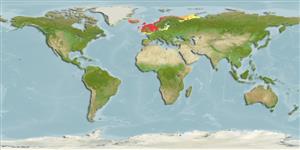Environment: milieu / climate zone / depth range / distribution range
Ecologia
marinhas; estuarina bentopelágico; intervalo de profundidade 10 - 150 m (Ref. 35388), usually 10 - 150 m (Ref. 35388). Temperate; 73°N - 49°N, 54°W - 60°E
Northeast Atlantic: 74°N (Novaya Zemlya and Bear Islands) to 49°N (Channel Islands, western English Channel), including eastern Greenland, Iceland, Barents Sea (but not the White Sea) and the Baltic (but not the Gulf of Bothnia and Finland).
Comprimento de primeira maturação / Tamanho / Peso / Idade
Maturity: Lm ?, range 11 - ? cm
Max length : 25.0 cm TL macho/indeterminado; (Ref. 232); idade máx. registrada: 10 anos (Ref. 35388)
Espinhos dorsais (total) : 0; Raios dorsais (total) : 56 - 63; Raios anais : 29 - 33. Scales absent from a median band anterior to the dorsal fin and from the musculature at the base of caudal fin. Belly scales loosely arranged, not in chevrons. Vertebrae 65-75. Margins of dorsal and anal fins straight with rays of equal length. Lateral line pores linearly arranged along the unbranched canals.
This schooling species is usually territorial and burrowing (Ref. 40). Feed on plankton. High activity is correlated to periods with strong tidal currents; then they leave their bottom hides and form large shoals. During low light intensity (night and winter) they bury in the bottom (Ref. 35388).
Muus, B.J. and J.G. Nielsen, 1999. Sea fish. Scandinavian Fishing Year Book, Hedehusene, Denmark. 340 p. (Ref. 35388)
Status na Lista Vermelha da UICN (Ref. 130435)
Ameaça para os humanos
Harmless
Uso pelos humanos
Pescarias: espécies comerciais
Ferramentas
Relatórios especiais
Baixar XML
Fontes da internet
Estimates based on models
Preferred temperature (Ref.
123201): 6.7 - 11, mean 9.7 °C (based on 1058 cells).
Índice de diversidade filogenética (Ref.
82804): PD
50 = 0.5156 [Uniqueness, from 0.5 = low to 2.0 = high].
Bayesian length-weight: a=0.00275 (0.00205 - 0.00370), b=3.14 (3.07 - 3.21), in cm total length, based on LWR estimates for this species (Ref.
93245).
Nível Trófico (Ref.
69278): 3.3 ±0.40 se; based on food items.
Resiliência (Ref.
120179): médio(a), tempo mínimo de duplicação da população 1,4 - 4,4 anos (K=0.16-0.89; tm=1-3; tmax=10; Fec=4,000).
Fishing Vulnerability (Ref.
59153): Low to moderate vulnerability (30 of 100).
Nutrients (Ref.
124155): Calcium = 44.2 [24.8, 86.8] mg/100g; Iron = 0.34 [0.20, 0.60] mg/100g; Protein = 18.6 [17.2, 19.8] %; Omega3 = 0.448 [0.217, 0.891] g/100g; Selenium = 14.2 [5.9, 30.8] μg/100g; VitaminA = 36.1 [12.4, 109.0] μg/100g; Zinc = 0.825 [0.582, 1.152] mg/100g (wet weight);
